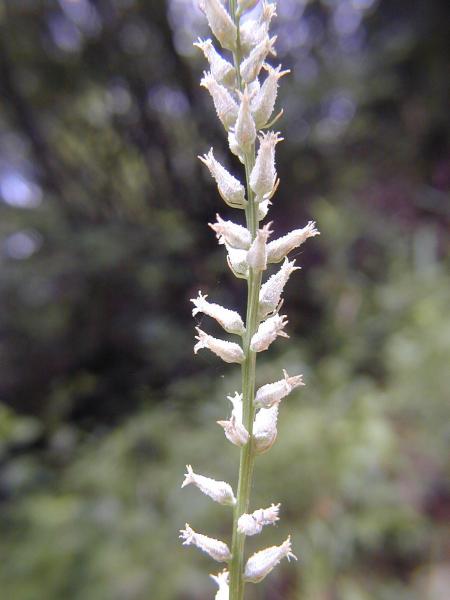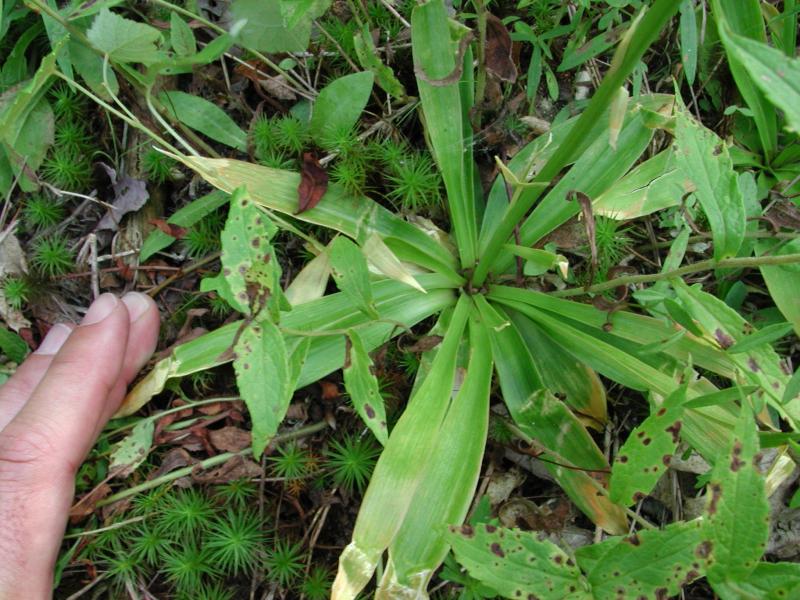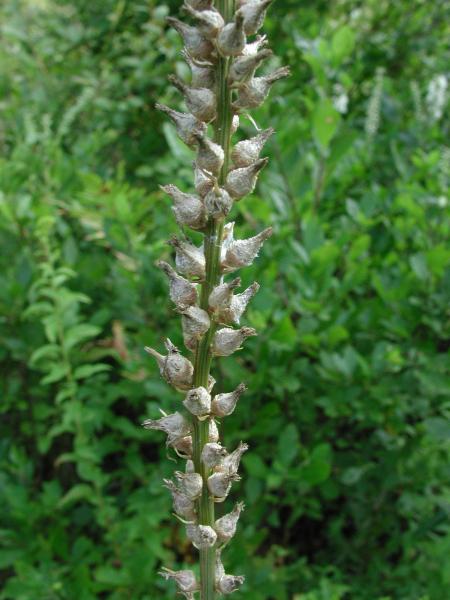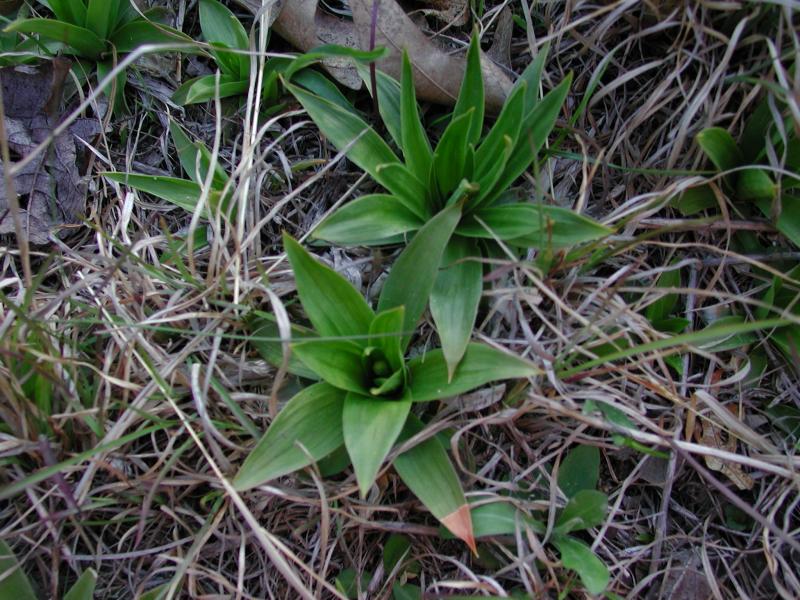White Colicroot
Aletris farinosa L.
- Class
- Monocotyledoneae (Monocots)
- Family
- Nartheciaceae
- State Protection
- Threatened
Listed as Threatened by New York State: likely to become Endangered in the foreseeable future. For animals, taking, importation, transportation, or possession is prohibited, except under license or permit. For plants, removal or damage without the consent of the landowner is prohibited.
- Federal Protection
- Not Listed
- State Conservation Status Rank
- S2
Imperiled in New York - Very vulnerable to disappearing from New York due to rarity or other factors; typically 6 to 20 populations or locations in New York, very few individuals, very restricted range, few remaining acres (or miles of stream), and/or steep declines.
- Global Conservation Status Rank
- G5
Secure globally - Common in the world; widespread and abundant (but may be rare in some parts of its range).
Summary
Did you know?
Stargrass is a medicinal plant and root preparations have been used to treat stomach and other problems, thus the name colic-root (Elliott 1995).
State Ranking Justification
There are 13 known populations but at least four of them are very small and subject to succession and other disturbances. There are about 10 records from the early 1900s that have not been searched. Some have been extirpated but some may be rediscovered because there is plenty of habitat still available.
Short-term Trends
The short-term trend appears stable but many occurrences have not been rechecked since the early 1990s.
Long-term Trends
There has been a moderate decline in sites and numbers in the past 50 years as development, especially on western Long Island has grown. The present larger sites should remain for the forseeable future.
Conservation and Management
Threats
A variety of disturbances and human activities threaten this species. The plant sometimes occur close to trails or sand roads and are threatened by being run over, mowed, or trampled. Road construction and housing developments as well as dumping have threatened populations. The open areas where the plants occur are also threatened by succession of the natural habitat to trees and shrubs.
Conservation Strategies and Management Practices
A buffer needs to be established around the plants so they are not directly impacted by human threats and succession needs to be kept at an herbaceous stage that does not outcompete the plants.
Research Needs
We would like to know how and in what form this species survives succession.
Habitat
Habitat
In New York, Stargrass is known from open, often wet areas within pine barrens and pine-oak forests, coastal plain pond margins, and sandy shorelines (New York Natural Heritage Program 2010). Rare in moist clearings (Rhoads and Block 2000). Sandy soil, open woods, and barrens (Gleason and Cronquist 1991). In moist or sometimes dry, usually sandy or sandy-mucky soil, on lake shores and in swales, meadows, clearings, and abandoned fields (Voss 1972). Dry or moist peats, sands, and gravels (Fernald 1970).
Associated Ecological Communities
- Coastal plain pond shore
(guide)
The gently sloping shore of a coastal plain pond with seasonally and annually fluctuating water levels. Plants growing on the pond shore vary with water levels. In dry years when water levels are low there is often a dense growth of annual sedges, grasses, and herbs. Submerged and floating-leaved aquatic plants, such as fragrant waterlily and pondweeds, may become "stranded" on the exposed shore. In wet years when the water level is high only a few emergents and floating-leaved aquatics may be noticeable. T
- Hempstead Plains grassland
(guide)
A tall grassland community that occurs on rolling outwash plains in west-central Long Island. This community occurs inland, beyond the influence of offshore winds and salt spray.
- Maritime grassland
(guide)
A grassland community that occurs on rolling outwash plains of the glaciated portion of the Atlantic coastal plain, near the ocean and within the influence of offshore winds and salt spray.
- Pitch pine-oak forest
(guide)
A mixed forest that typically occurs on well-drained, sandy soils of glacial outwash plains or moraines; it also occurs on thin, rocky soils of ridgetops. The dominant trees are pitch pine mixed with one or more of the following oaks: scarlet oak, white oak, red oak, or black oak.
- Pitch pine-scrub oak barrens
(guide)
A shrub-savanna community that occurs on well-drained, sandy soils that have developed on sand dunes, glacial till, and outwash plains.
- Successional northern sandplain grassland
(guide)
A meadow community that occurs on open sandplains that have been cleared and plowed (for farming or development), and then abandoned. This community is usually dominated by low, dry turf of sedges and grasses less than 30 cm (12 inches) tall, and include patches of open sand and patches of soil covered with mosses and lichens.
Associated Species
- Agalinis setacea (needle-leaved agalinis)
- Andropogon glomeratus
- Andropogon virginicus
- Anthoxanthum odoratum (sweet vernal grass)
- Baptisia sp.
- Bartonia virginica (Virginia screwstem)
- Calamagrostis cinnoides (small reed grass)
- Carex barrattii (Barratt's sedge)
- Carex bullata (button sedge)
- Carex swanii (Swan's sedge)
- Chrysopsis mariana (Maryland golden-aster)
- Clethra alnifolia (coastal sweet-pepperbush)
- Comptonia peregrina (sweet-fern)
- Dicanthelium spp.
- Dichanthelium sp.
- Drosera intermedia (spatulate-leaved sundew)
- Drosera rotundifolia (round-leaved sundew)
- Eupatorium pilosum (ragged thoroughwort)
- Eurybia spectabilis (showy-aster)
- Euthamia tenuifolia
- Gaylussacia baccata (black huckleberry)
- Hypericum canadense (lesser Canadian St. John's-wort)
- Hypericum sp.
- Hypoxis hirsuta (yellow star-grass)
- Juncus canadensis (Canada rush)
- Juncus effus
- Lechea sp.
- Lespedeza cuneata (Asian bush-clover)
- Linum sp.
- Liquidambar styraciflua (sweet-gum)
- Lobelia nuttallii (Nuttall's lobelia)
- Maianthemum canadense (Canada mayflower)
- Myrica sp.
- Onoclea sensibilis (sensitive fern)
- Pinus rigida (pitch pine)
- Platanthera blephariglottis
- Platanthera lacera (ragged fringed orchid)
- Polygala nuttallii (Nuttall's milkwort)
- Prenanthes sp.
- Prunella vulgaris
- Quercus alba (white oak)
- Rhynchospora capillacea (hair beak sedge)
- Rhynchospora capitellata (brownish beak sedge)
- Rubus hispidus (swamp dewberry)
- Schizachyrium scoparium
- Scirpus hattorianus (mosquito bulrush)
- Scleria minor (slender nut sedge)
- Scleria triglomerata (whip nut sedge)
- Solidago nemoralis
- Sorghastrum nutans (Indian grass)
- Spiranthes cernua (nodding ladies'-tresses)
- Spiranthes tuberosa (little ladies'-tresses)
- Symphyotrichum lateriflorum (calico-aster)
- Vaccinium angustifolium (common lowbush blueberry)
- Vaccinium corymbosum (highbush blueberry)
Range
New York State Distribution
This species is currently known from Long Island, mainly the pine barrens of Suffolk County, but also from Nassau County. It is historically known from the New York City area and Staten Island where it is considered extirpated. There is also an 1837 record from Manlius, near Syracuse but no specimen to confirm the report.
Global Distribution
This species grows south from New England and southern Canada to Florida and west through Texas.
Identification Comments
General Description
Stargrass is a perennial herb with a basal rosette of broad, grass-like leaves. From this base arises a central stalk. The top portion of the stalk bears an infloresence of many nearly sessile flowers. The flowers are white, with mostly fused petals from 7 to 10 millimeters long.
Best Life Stage for Proper Identification
Stargrass is likely most obvious when in flower, but may also be identified when in fruit or even from its basal rosettes.
Similar Species
The combination of a basal rosette of flat, leathery leaves, and the central raceme of small white flowers are distinctive in New York.
Best Time to See
Vegetative leaves are visible year-round. If the plant flowers, the flowers appear between early June to mid-July. The fruits often persist until after the first hard frost.
- Vegetative
- Flowering
- Fruiting
The time of year you would expect to find White Colicroot vegetative, flowering, and fruiting in New York.
White Colicroot Images
Taxonomy
White Colicroot
Aletris farinosa L.
- Kingdom Plantae
- Phylum Anthophyta
- Class Monocotyledoneae
(Monocots)
- Order Dioscoreales
- Family Nartheciaceae
- Order Dioscoreales
- Class Monocotyledoneae
(Monocots)
- Phylum Anthophyta
Additional Common Names
- Ague
- Colic-root
- Stargrass
- Unicorn-root
Additional Resources
Best Identification Reference
Flora of North America Editorial Committee. 2002. Flora of North America, North of Mexico. Volume 26. Magnoliophyta: Liliidae: Liliales and Orchidales. Oxford University Press, New York. 723 pp.
Other References
Clemants, Steven and Carol Gracie. 2006. Wildflowers in the Field and Forest. A Field Guide to the Northeastern United States. Oxford University Press, New York, NY. 445 pp.
Elliott, D. 1995. Wild Roots: A Forager's Guide to the Edible and Medicinal Roots, Tubers, Corms, and Rhizomes of North America. Healing Arts Press, Rochester, Vermont. Pp. 30-31.
Fernald, M. L. 1950. Gray's manual of botany. 8th edition. Corrected printing (1970). D. Van Nostrand Company, New York. 1632 pp.
Gleason, Henry A. and A. Cronquist. 1991. Manual of Vascular Plants of Northeastern United States and Adjacent Canada. The New York Botanical Garden, Bronx, New York. 910 pp.
Holmgren, Noel. 1998. The Illustrated Companion to Gleason and Cronquist's Manual. Illustrations of the Vascular Plants of Northeastern United States and Adjacent Canada. The New York Botanical Garden, Bronx, New York.
New York Natural Heritage Program. 2024. New York Natural Heritage Program Databases. Albany, NY.
Newcomb, Lawrence. 1977. Newcomb's Wildflower Guide: An Ingenious New Key System for Quick, Positive Field Identification of the Wildflowers, Flowering Shrubs, and Vines of Northeastern and North-Central North America. Little, Brown and Company. Boston.
Weldy, T. and D. Werier. 2010. New York flora atlas. [S.M. Landry, K.N. Campbell, and L.D. Mabe (original application development), Florida Center for Community Design and Research http://www.fccdr.usf.edu/. University of South Florida http://www.usf.edu/]. New York Flora Association http://newyork.plantatlas.usf.edu/, Albany, New York
Links
About This Guide
Information for this guide was last updated on: February 23, 2011
Please cite this page as:
New York Natural Heritage Program. 2024.
Online Conservation Guide for
Aletris farinosa.
Available from: https://guides.nynhp.org/stargrass/.
Accessed July 27, 2024.



